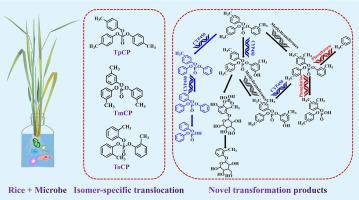Environment International ( IF 10.3 ) Pub Date : 2023-02-02 , DOI: 10.1016/j.envint.2023.107793 Yuanyuan Yu 1 , Jiahui Huang 1 , Ling Jin 2 , Miao Yu 3 , Xiaolong Yu 1 , Xifen Zhu 1 , Jianteng Sun 1 , Lizhong Zhu 4

|
Tricresyl phosphate (TCP) is extensively used organophosphorus flame retardants and plasticizers that posed risks to organisms and human beings. In this study, the translocation and biotransformation behavior of isomers tri-p-cresyl phosphate (TpCP), tri-m-cresyl phosphate (TmCP), and tri-o-cresyl phosphate (ToCP) in rice and rhizosphere microbiome was explored by hydroponic exposure. TpCP and TmCP were found more liable to be translocated acropetally, compared with ToCP, although they have same molecular weight and similar Kow. Rhizosphere microbiome named microbial consortium GY could reduce the uptake of TpCP, TmCP, and ToCP in rice tissues, and promote rice growth. New metabolites were successfully identified in rice and microbiome, including hydrolysis, hydroxylated, methylated, demethylated, methoxylated, and glucuronide- products. The methylation, demethylation, methoxylation, and glycosylation pathways of TCP isomers were observed for the first time in organisms. What is more important is that the demethylation of TCPs could be an important and overlooked source of triphenyl phosphate (TPHP), which broke the traditional understanding of the only manmade source of toxic TPHP in the environment. Active members of the microbial consortium GY during degradation were revealed and metagenomic analysis indicated that most of active populations contained TCP-degrading genes. It is noteworthy that the strains and function genes in microbial consortium GY that responsible for TCP isomers’ transformation were different. These results can improve our understanding of the translocation and transformation of organic pollutant isomers in plants and rhizosphere microbiome.
中文翻译:

磷酸三甲苯酯在水稻和微生物组系统中的转运和代谢:异构体特异性过程和被忽视的代谢物
磷酸三甲苯酯 (TCP) 是一种广泛使用的有机磷阻燃剂和增塑剂,对生物体和人类构成威胁。本研究通过水培法探索了异构体磷酸三对甲酚 (TpCP)、磷酸三甲酚 (TmCP) 和磷酸三邻甲酚 (ToCP) 在水稻和根际微生物组中的易位和生物转化行为接触。与 ToCP 相比,TpCP 和 TmCP 被发现更容易在头顶移位,尽管它们具有相同的分子量和相似的K ow. 名为微生物聚生体 GY 的根际微生物组可以减少水稻组织中 TpCP、TmCP 和 ToCP 的吸收,促进水稻生长。在水稻和微生物组中成功鉴定出新的代谢物,包括水解、羟基化、甲基化、去甲基化、甲氧基化和葡糖苷酸产物。首次在生物体中观察到TCP异构体的甲基化、去甲基化、甲氧基化和糖基化途径。更重要的是,TCPs 的去甲基化可能是磷酸三苯酯 (TPHP) 的一个重要且被忽视的来源,这打破了人们对环境中有毒 TPHP 唯一人造来源的传统认识。揭示了降解过程中微生物联合体 GY 的活跃成员,宏基因组分析表明大多数活跃种群都含有 TCP 降解基因。值得注意的是,负责TCP异构体转化的微生物聚生体GY中的菌株和功能基因是不同的。这些结果可以提高我们对有机污染物异构体在植物和根际微生物群中的易位和转化的理解。

































 京公网安备 11010802027423号
京公网安备 11010802027423号